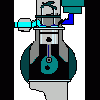XU-1 Torry
55amp alt
Odessey battery.
Battery Isolator switch
Battery mounted on passenger side front floor.
Charge wire from alt to battery is isolated unless current is flowing through battery isolator switch.This is done with a 60amp relay.
*At fast idle (above 1800rpm) showing 13.5v @alt and 13v @battery.
*Increase in idle does not change either value.
*amp gauge is showing a charge rate of 30 amps.This is running the ignition circuit a s well as 2 holley blues.
* Turn on thermo fan and amp rate increases to 40amps.BUT the voltage now drops to 12.8 @ the battery and 13.3 @the alt.
*After 5-10 mins running the amp rate will drop slightly but the Voltage never climbs back over 12.8@ battery unless you turn the thermo back off.
My Question.....
Firstly..... can anyone see a problem here??? cause I think the Volts are a little low and the charge rate seems excesive???
Secondly......Is there much of a problem with the loss of .5 Volts from the alt to the battery??
Thirdly....is the output of the alt OK @13.5 volts??? They are supposed to be between 13.8 and 14.2 volts aren't they???
HELP got a race in 2 weeks and I don't need Electrical gremlins!!!
Cheers Greg..
Edited by 82911, 23 March 2006 - 05:25 PM.

















